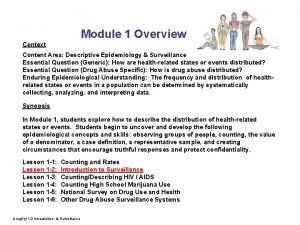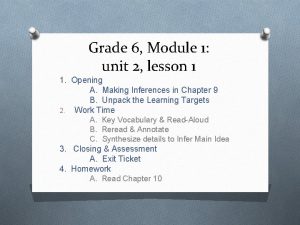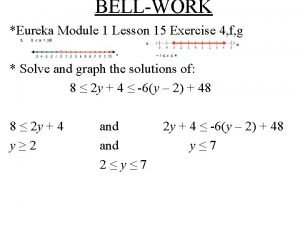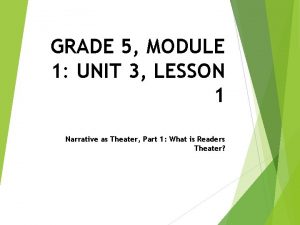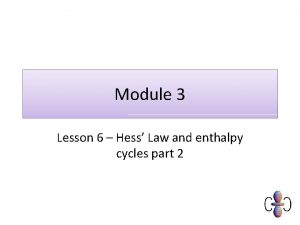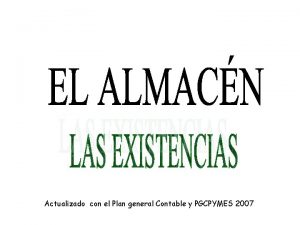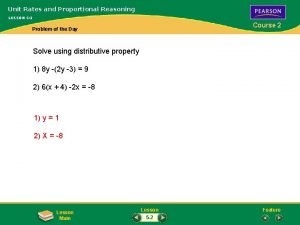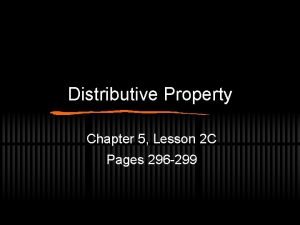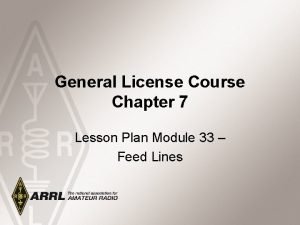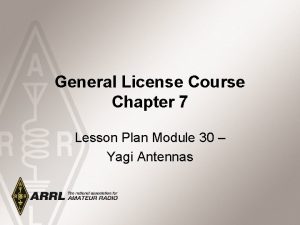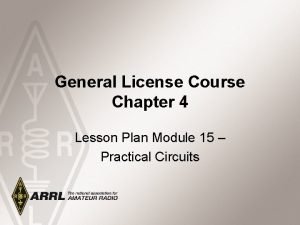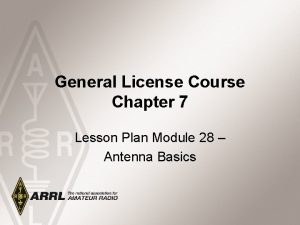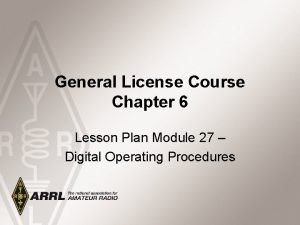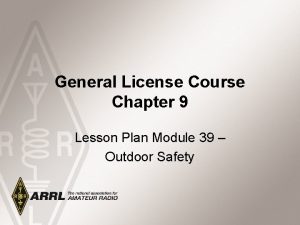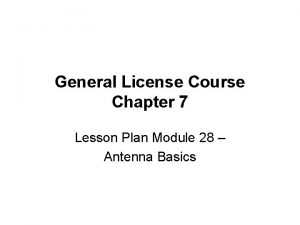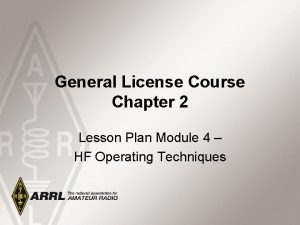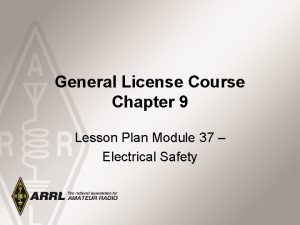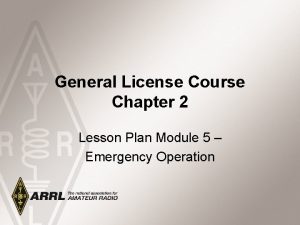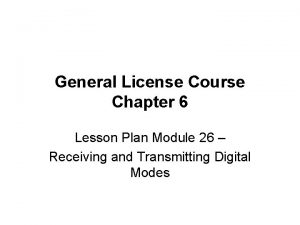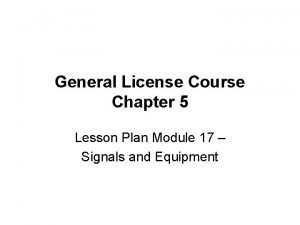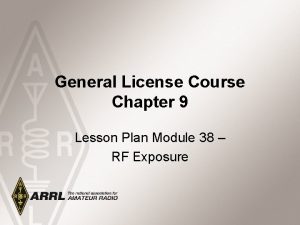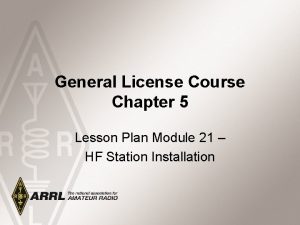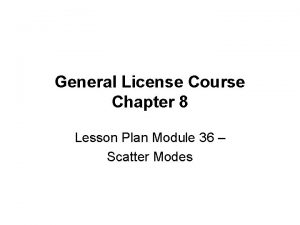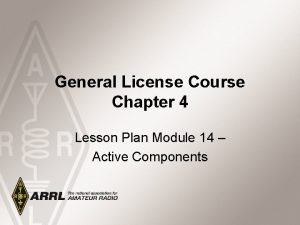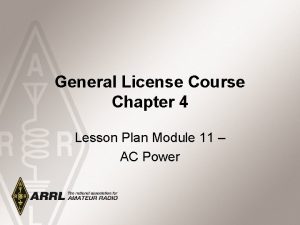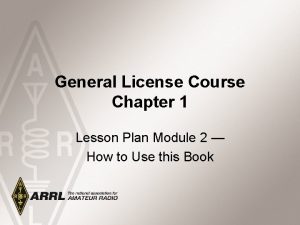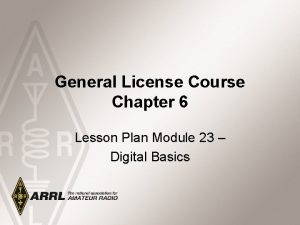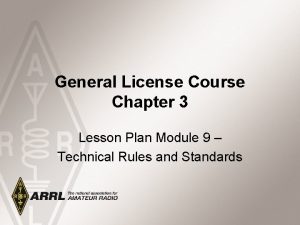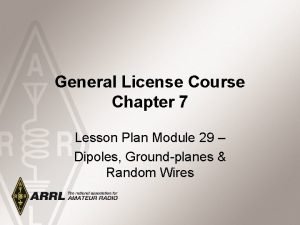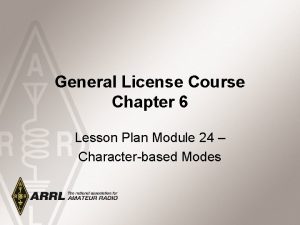General License Course Chapter 4 Lesson Plan Module







































- Slides: 39

General License Course Chapter 4 Lesson Plan Module 13 – Reactance and Impedance

Reactance • Definition: The resistance to the flow of ac current caused by capacitance or inductance is called reactance and is denoted by X. It is measured in ohms, like resistance. 2015 General License Course 2

Reactance • Capacitive reactance: The opposition to ac current flow from the stored energy in a capacitor is called capacitive reactance (XC) • As the frequency of the applied signal increases, XC decreases. and vice versa 2015 General License Course 3

Reactance • Inductive reactance is the opposition to ac current flow from the stored energy in a inductor and is denoted by XL • As the frequency of the applied signal increases, XL increases and visa versa 2015 General License Course 4

Impedance • Impedance - opposition to current flow in an ac circuit • Denoted by “Z” and is measured in ohms ( ) • The ratio of voltage to current 2015 General License Course 5

Resonance • Resonance in a circuit or antenna occurs when capacitive and inductive reactance are equal • In a resonant series circuit the reactances of the L and C cancel, forming a short circuit, leaving only the resistance, R, as the circuit’s impedance • Resonance is used in filters or tuned circuits to pass or reject specific frequencies 2015 General License Course 6

Impedance Transformation • A transformer changes the ratio of voltage and current between the primary and secondary circuits and so changes the impedance • Zp = Zs (Np / Ns)2 and √(Zp / Zs) = Np / Ns • Example 27: What turns ratio is required to change a 600 Ω impedance to a 4 Ω impedance? Keystrokes: 600 / 4 = 150 [sq root] =12. 24744871, rounded to 12. 25 : 1 2015 General License Course 7

Impedance Matching • Maximum power transfer occurs when the source and load impedances are equal • Amateur transmitting equipment is designed to have a 50 output • Most antennas are designed to have a feed point impedance of 50 but rarely present that impedance over the whole band • An impedance-matching circuit changes the variable impedance into the desired value 2015 General License Course 8

Impedance Matching Most impedance matching circuits are LC circuits made up of inductors and capacitors 2015 General License Course 9

Impedance Matching • Special RF impedance-matching transformers are often used to equalize impedances of the source and load to maximize the transfer of power to the load • Special lengths of coax can be used to match impedances 2015 General License Course 10

Practice Questions 2015 General License Course

What is impedance? A. The electric charge stored by a capacitor B. The inverse of resistance C. The opposition to the flow of current in an AC circuit D. The force of repulsion between two similar electric fields G 5 A 01 2015 General License Course

What is impedance? A. The electric charge stored by a capacitor B. The inverse of resistance C. The opposition to the flow of current in an AC circuit D. The force of repulsion between two similar electric fields G 5 A 01 2015 General License Course

What is reactance? A. Opposition to the flow of direct current caused by resistance B. Opposition to the flow of alternating current caused by capacitance or inductance C. A property of ideal resistors in AC circuits D. A large spark produced at switch contacts when an inductor is de-energized G 5 A 02 2015 General License Course

What is reactance? A. Opposition to the flow of direct current caused by resistance B. Opposition to the flow of alternating current caused by capacitance or inductance C. A property of ideal resistors in AC circuits D. A large spark produced at switch contacts when an inductor is de-energized G 5 A 02 2015 General License Course

Which of the following causes opposition to the flow of alternating current in an inductor? A. Conductance B. Reluctance C. Admittance D. Reactance G 5 A 03 2015 General License Course

Which of the following causes opposition to the flow of alternating current in an inductor? A. Conductance B. Reluctance C. Admittance D. Reactance G 5 A 03 2015 General License Course

Which of the following causes opposition to the flow of alternating current in a capacitor? A. Conductance B. Reluctance C. Reactance D. Admittance G 5 A 04 2015 General License Course

Which of the following causes opposition to the flow of alternating current in a capacitor? A. Conductance B. Reluctance C. Reactance D. Admittance G 5 A 04 2015 General License Course

How does an inductor react to AC? A. As the frequency of the applied AC increases, the reactance decreases B. As the amplitude of the applied AC increases, the reactance increases C. As the amplitude of the applied AC increases, the reactance decreases D. As the frequency of the applied AC increases, the reactance increases G 5 A 05 2015 General License Course

How does an inductor react to AC? A. As the frequency of the applied AC increases, the reactance decreases B. As the amplitude of the applied AC increases, the reactance increases C. As the amplitude of the applied AC increases, the reactance decreases D. As the frequency of the applied AC increases, the reactance increases G 5 A 05 2015 General License Course

How does a capacitor react to AC? A. As the frequency of the applied AC increases, the reactance decreases B. As the frequency of the applied AC increases, the reactance increases C. As the amplitude of the applied AC increases, the reactance increases D. As the amplitude of the applied AC increases, the reactance decreases G 5 A 06 2015 General License Course

How does a capacitor react to AC? A. As the frequency of the applied AC increases, the reactance decreases B. As the frequency of the applied AC increases, the reactance increases C. As the amplitude of the applied AC increases, the reactance increases D. As the amplitude of the applied AC increases, the reactance decreases G 5 A 06 2015 General License Course

What happens when the impedance of an electrical load is equal to the output impedance of a power source, assuming both impedances are resistive? A. The source delivers minimum power to the load B. The electrical load is shorted C. No current can flow through the circuit D. The source can deliver maximum power to the load G 5 A 07 2015 General License Course

What happens when the impedance of an electrical load is equal to the output impedance of a power source, assuming both impedances are resistive? A. The source delivers minimum power to the load B. The electrical load is shorted C. No current can flow through the circuit D. The source can deliver maximum power to the load G 5 A 07 2015 General License Course

Why is impedance matching important? A. So the source can deliver maximum power to the load B. So the load will draw minimum power from the source C. To ensure that there is less resistance than reactance in the circuit D. To ensure that the resistance and reactance in the circuit are equal G 5 A 08 2015 General License Course

Why is impedance matching important? A. So the source can deliver maximum power to the load B. So the load will draw minimum power from the source C. To ensure that there is less resistance than reactance in the circuit D. To ensure that the resistance and reactance in the circuit are equal G 5 A 08 2015 General License Course

What unit is used to measure reactance? A. Farad B. Ohm C. Ampere D. Siemens G 5 A 09 2015 General License Course

What unit is used to measure reactance? A. Farad B. Ohm C. Ampere D. Siemens G 5 A 09 2015 General License Course

What unit is used to measure impedance? A. Volt B. Ohm C. Ampere D. Watt G 5 A 10 2015 General License Course

What unit is used to measure impedance? A. Volt B. Ohm C. Ampere D. Watt G 5 A 10 2015 General License Course

Which of the following describes one method of impedance matching between two AC circuits? A. Insert an LC network between the two circuits B. Reduce the power output of the first circuit C. Increase the power output of the first circuit D. Insert a circulator between the two circuits G 5 A 11 2015 General License Course

Which of the following describes one method of impedance matching between two AC circuits? A. Insert an LC network between the two circuits B. Reduce the power output of the first circuit C. Increase the power output of the first circuit D. Insert a circulator between the two circuits G 5 A 11 2015 General License Course

What is one reason to use an impedance matching transformer? A. To minimize transmitter power output B. To maximize the transfer of power C. To reduce power supply ripple D. To minimize radiation resistance G 5 A 12 2015 General License Course

What is one reason to use an impedance matching transformer? A. To minimize transmitter power output B. To maximize the transfer of power C. To reduce power supply ripple D. To minimize radiation resistance G 5 A 12 2015 General License Course

Which of the following devices can be used for impedance matching at radio frequencies? A. A transformer B. A Pi-network C. A length of transmission line D. All of these choices are correct G 5 A 13 2015 General License Course

Which of the following devices can be used for impedance matching at radio frequencies? A. A transformer B. A Pi-network C. A length of transmission line D. All of these choices are correct G 5 A 13 2015 General License Course

What is the ratio of peak envelope power to average power for an unmodulated carrier? A. 0. 707 B. 1. 00 C. 1. 414 D. 2. 00 G 5 B 11

What is the ratio of peak envelope power to average power for an unmodulated carrier? A. 0. 707 B. 1. 00 C. 1. 414 D. 2. 00 G 5 B 11
 Meaning of micro teaching
Meaning of micro teaching Objective of evs
Objective of evs C device module module 1
C device module module 1 Supervisor safety leadership training
Supervisor safety leadership training Course module sample
Course module sample Ravi poured the milk for the kitten that he brought from
Ravi poured the milk for the kitten that he brought from One and a half brick wall
One and a half brick wall Course title and course number
Course title and course number Course interne course externe
Course interne course externe Ahrs army
Ahrs army Getting a drivers license illegally may result in
Getting a drivers license illegally may result in Chapter 1 nj driver license system
Chapter 1 nj driver license system Chapter 1 the new jersey driver license system answers
Chapter 1 the new jersey driver license system answers An overall state of well-being or total health
An overall state of well-being or total health Chapter 7 lesson 3 a new plan of government
Chapter 7 lesson 3 a new plan of government Planos en cinematografia
Planos en cinematografia Where did general lee surrender to general grant?
Where did general lee surrender to general grant? Hardship and suffering during the depression
Hardship and suffering during the depression Module 5 lesson 5
Module 5 lesson 5 Eureka math grade 6 module 1 answer key
Eureka math grade 6 module 1 answer key Practical/logistical issues in relationships examples
Practical/logistical issues in relationships examples Grade 6 module
Grade 6 module Module eleven lesson one self check quiz
Module eleven lesson one self check quiz Eureka math algebra 1 module 1 lesson 15
Eureka math algebra 1 module 1 lesson 15 Grade 5 module 1 lesson 1
Grade 5 module 1 lesson 1 Intersecting chords
Intersecting chords Module 3 lesson 6
Module 3 lesson 6 Course plan ppt
Course plan ppt Plan contable
Plan contable General arrangement vessel
General arrangement vessel Contoh stowage plan tongkang
Contoh stowage plan tongkang National general benefits solutions providers
National general benefits solutions providers Non recursive algorithm
Non recursive algorithm Describe the schlieffen plan
Describe the schlieffen plan Plan general contable actualizado
Plan general contable actualizado Course 2 chapter 1 ratios and proportional reasoning
Course 2 chapter 1 ratios and proportional reasoning Steve wyborney multiplication course chapter 1
Steve wyborney multiplication course chapter 1 Chapter 13 personal financial management course
Chapter 13 personal financial management course Course 2 chapter 3 integers
Course 2 chapter 3 integers Lesson 2 the distributive property
Lesson 2 the distributive property




